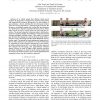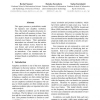189 search results - page 26 / 38 » Context-Aware Saliency Detection |
ETRA
2008
ACM
13 years 8 months ago
2008
ACM
Under natural viewing conditions, human observers use shifts in gaze to allocate processing resources to subsets of the visual input. There are many computational models that try ...
ICRA
2008
IEEE
14 years 1 months ago
2008
IEEE
— It is widely agreed that efficient visual search requires the integration of target-driven top-down information and image-driven bottom-up information. Yet the problem of gaze...
COLING
2008
13 years 8 months ago
2008
This paper presents a probabilistic model for Japanese zero anaphora resolution. First, this model recognizes discourse entities and links all mentions to them. Zero pronouns are ...
ICIP
2010
IEEE
13 years 4 months ago
2010
IEEE
Close-up (CU) is a photographic technique which tightly frames a person or an object. In movies, it is applied to guide audience attention and to evoke audience emotion. In this p...
NIPS
2007
13 years 8 months ago
2007
Current computational models of bottom-up and top-down components of attention are predictive of eye movements across a range of stimuli and of simple, fixed visual tasks (such a...


